Associating Climatic Trends with Stochastic Modelling of Flow Sequences
Abstract
1. Introduction
2. Backgroud
2.1. Impact of Climate Change on ENSO Events
2.2. Data-Driven Approaches for Predicting Streamflow under the Climatic Influence (Extreme Events)
3. Case Study and Data Organisation
3.1. Study Area
3.2. River Runoff, Precipitation and Evapotranspiration Data
4. Research Methodology
4.1. The Methodological Framework of the HMM_GP Model
- Stage 1 (Orange)—Time series decomposition using a robust STL (a seasonal-trend decomposition procedure based on Loess) [59]: the STL procedure facilitates a temporal decomposition of observed time series (O) into three components: (i) long-term trends (); (ii) seasonal movements (S); and (iii) random variations(R).Since the STL procedure is mostly suitable for additive decomposition, input time series are recommended for a log transformation. The data pre-processing is intended to stabilise variance in non-stationary series and to de-emphasise the influence of extreme values (outliers). A detailed literature review covering a detailed overview of the STL method, along with other closely related mathematical techniques for time series decomposition, such as empirical mode decomposition (EDM), can be found elsewhere [58,60,61].
- Stage 2 (Blue)—Fitting of the hidden Markov model (HMM) to the random component: application of the HMM model to the random component facilitates the simulation of uncertainty/randomness associated with the process. The theoretical structure of the HMM model is comprised of five components, as represented in Table 2. Table 2 also details the procedure of fitting the HMM model to the random component used within the HMM_GP framework.The HMM model fitted to the random component is used to simulate n− user-specified random components. These synthetic random components are then combined with the trend and seasonal components of the observed series to construct n synthetic time series corresponding to the original series.
- Stage 3 (Green)—Fitting GEV or GP distribution: to effectively simulate extreme values, a GEV or GP distribution is fitted to extreme values, specifically in the range of 95th–99.9th percentiles, in the observed series. All synthetically simulated series are then processed to resample extreme values from the fitted distribution. This step ensures that the extreme limits of the synthetic sequences are not constrained by the observed dataset and the fitted continuous distribution allows to incorporate unseen extreme events in the synthetic series. A technical discussion on the appropriateness of selecting a GEV or GP distribution can be found elsewhere [62].
- Stage 4 (Yellow)—Bias Correction: data transformation procedure involving log-transformation and back transformation often produces biased predictions [63]. To minimise the influence of the data transformation procedure, a novel percentile-based bias correction is applied to synthetic series so that synthetic data are not out of synch with actual data.
- (a)
- Time series of has a considerably small range, , and does not exhibit an overly long-tailed distribution (long-tailed or heavy-tailed distributions are those with extended tails in either the right or left or both directions, due to several values occurring far from the mean or central part of the distribution. Long-tailed distributions are mainly studied within the context of extreme value distribution). However, the time series of the dataset does not exhibit an overly long-tailed distribution. Therefore, to process the dataset requires some adaptation in Stage 3. Specifically, we chose to fit a GEV distribution rather than a GP type distribution in the observed time series of , as detailed in [62].
- (b)
- Time series of P has a wide range of values with many zero values and a long-tailed distribution. For the time series of P, as there can be valid zero elements of the series, we shift the series by a very small translation, 0.001, so that we can take the of the series. As the data are available in two decimal places and range from 0.01 to 136.83, this small value does not represent a significant change to the data and does not excessively stretch (on the negative side) the range of values that the log of the series takes (note this is significant when fitting an HMM to the data). Stages 1 and 2 are applied, and after transforming the synthetics series, we subtract the small shift value, 0.001, from the synthetic series. In contrast to the data, in Stage 3, as the distribution for the P data is very long-tailed, thus, we choose to fit a GP distribution.
- (c)
- The time series of Q has a very wide range, , and a long-tailed distribution. A climatic module is developed to integrate the influence of and P data in simulated Q sequences, detailed in the next subsection.
4.2. Calibrating ‘Climatic Module’ for Simulating Q Sequences
- 1
- We take the log of the Q time series to convert a multiplicative time series into an additive series.
- 2
- Using the Loess method of time series decomposition from [59], we decomposed the series into trends, seasonality, and random components.
- 3
- We fit a linear regression model for the response of the decomposed trend of the series to the trends generated by decomposition of and , as described in Section 4.1 above:Accordingly, we complete the generation of n synthetic series for the Q data complementing the synthetic series generated for P and with the following steps:
- 4
- We fit an HMM to the of random component.
- 5
- Using the HMM, we generate the prescribed number of synthetic random series for a pre-determined length of time (less than or equal to that of the P and length).
- 6
- We recombined the decomposed series by adding the seasonality component for the from Step 2 and the trend fitted by the linear regression model to each of the N synthetic random series from Step 5.
- 7
- Take the exponential of each of the N resultant series from Step 6.
- 8
- Re-sample extreme values in the synthetic series from a GP distribution fitted to the extreme values in the actual Q data, as detailed in Stage 3. As the distribution for the Q data is very long-tailed, we choose to fit a GP distribution and apply Stage 4 from Section 4.1.
4.3. Application of ‘Climatic Module’ for Forecasting Q Sequences
- 1
- We split the time-frame T for our data into two segments and , such that the start date in the year for both and is the same (to ensure the correct starting probabilities for our fitted HMM). Note we also assume that .
- 2
- For the inflow data in the time-frame, we follow the initial steps for generating synthetic inflow series up to fitting an HMM to the random decomposed series, including generating the linear regression model for the trend on the time period .
- 3
- Using the HMM fitted for the inflow data in the time period generates the prescribed number (N) of synthetic random series for the time period .
- 4
- For the manufacture of the synthetic Q series for time period by adding the predicted random series, the predicted trend for the Q uses the linear model whose parameters are fitted from the data in the time period and generated using the P and trend from time period , and the seasonal inflow component is generated by using the annual seasonal component decomposed in the time period .
- 5
- Take the exponential of each of the N resultant series.
- 6
- Re-sample extreme values in the synthetic series from a GP distribution fitted to the extreme values in the actual Q data, as detailed in Stage 3, and apply a percentile bias, as detailed in Stage 4.
5. Results
5.1. STL Decomposition of , P and Q
5.2. Calibration of the HMM_GP Model for Simulating Synthetics Sequences
5.3. Calibration of ‘Climatic Module’
5.4. Model Prediction
5.5. Model Application: Uncertainty in Reservoir Capacity Estimates
6. Discussion
Author Contributions
Funding
Institutional Review Board Statement
Informed Consent Statement
Data Availability Statement
Acknowledgments
Conflicts of Interest
Nomenclature
| Evapotranspiration | |
| P | Precipitation |
| T | Temperature |
| ANN | Artificial neural network |
| BBMB | Bhakra Beas Management Board |
| DBN | Deep belief network |
| ENSO | El Niño/Southern Oscillation |
| GEV | Generalised extreme value |
| GP | Generalised Pareto |
| HMM | Hidden Markov model |
| IMD | Indian Meteorological Department |
| Q | Inflow sequences |
| R | Random |
| S | Seasonal |
| SVR | Support vector regression |
| Tr | Trend |
| USGS | U.S. Geological Survey |
| WANN | Wavelet-based Artificial neural network |
Appendix A
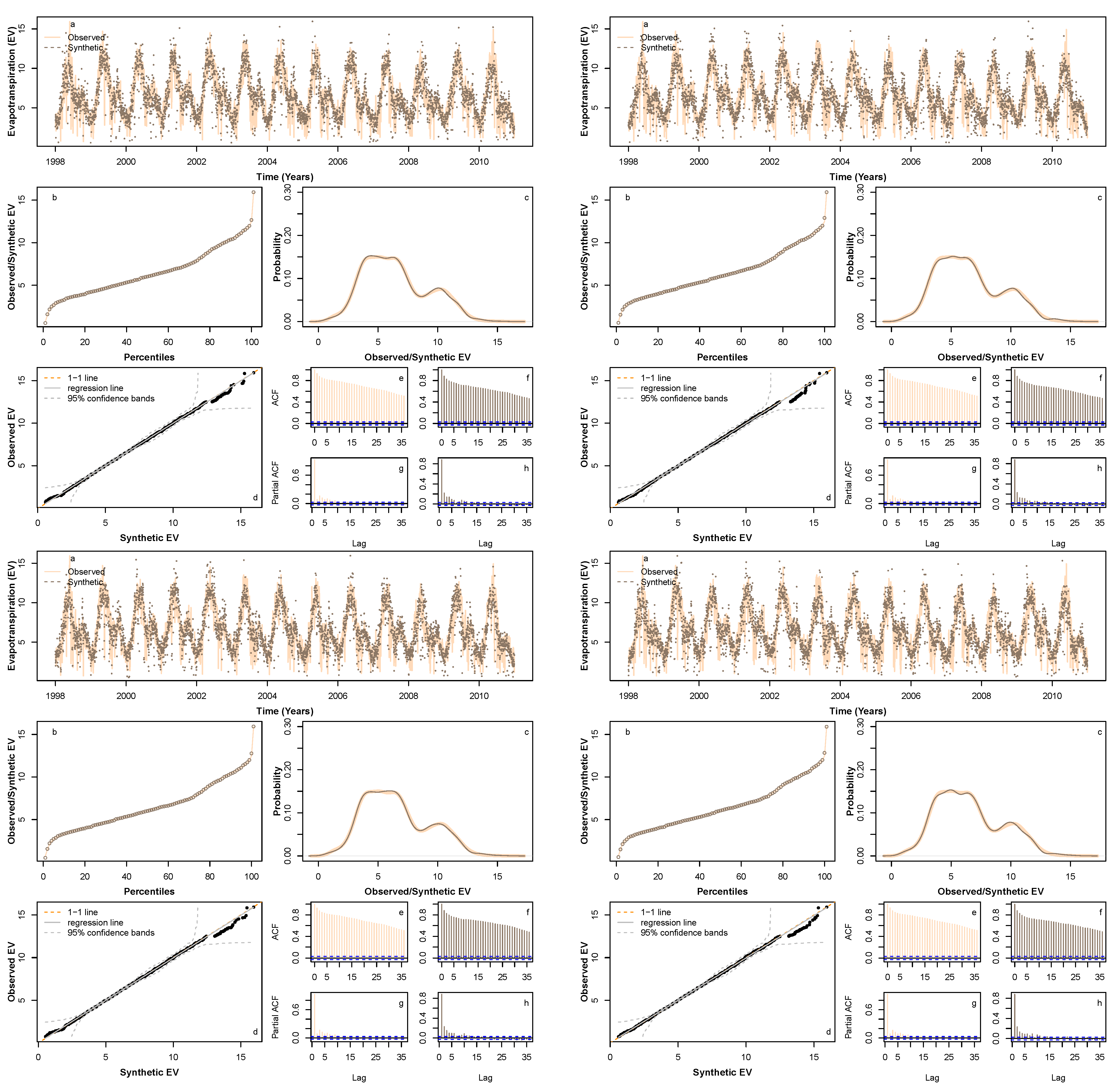
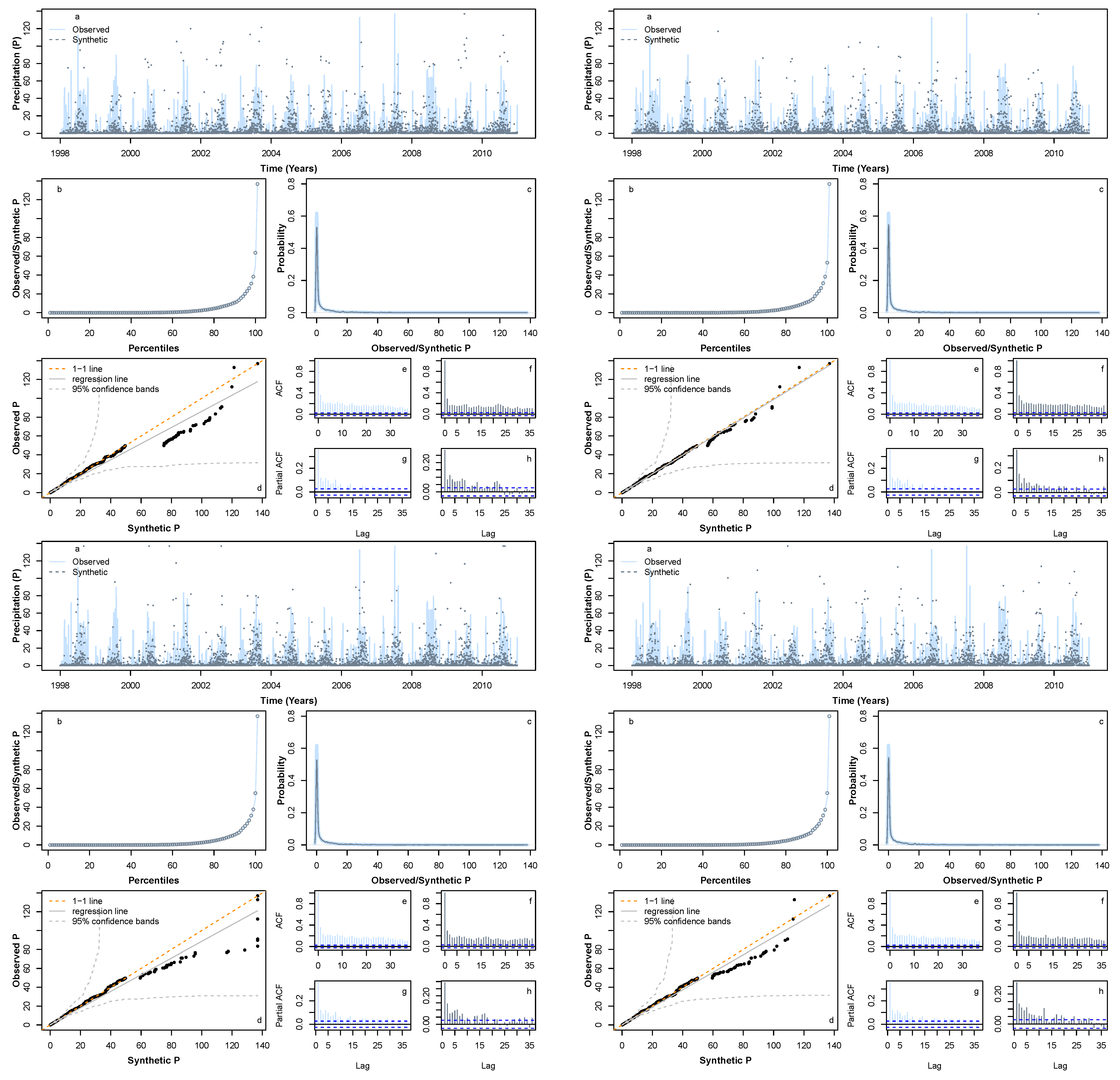
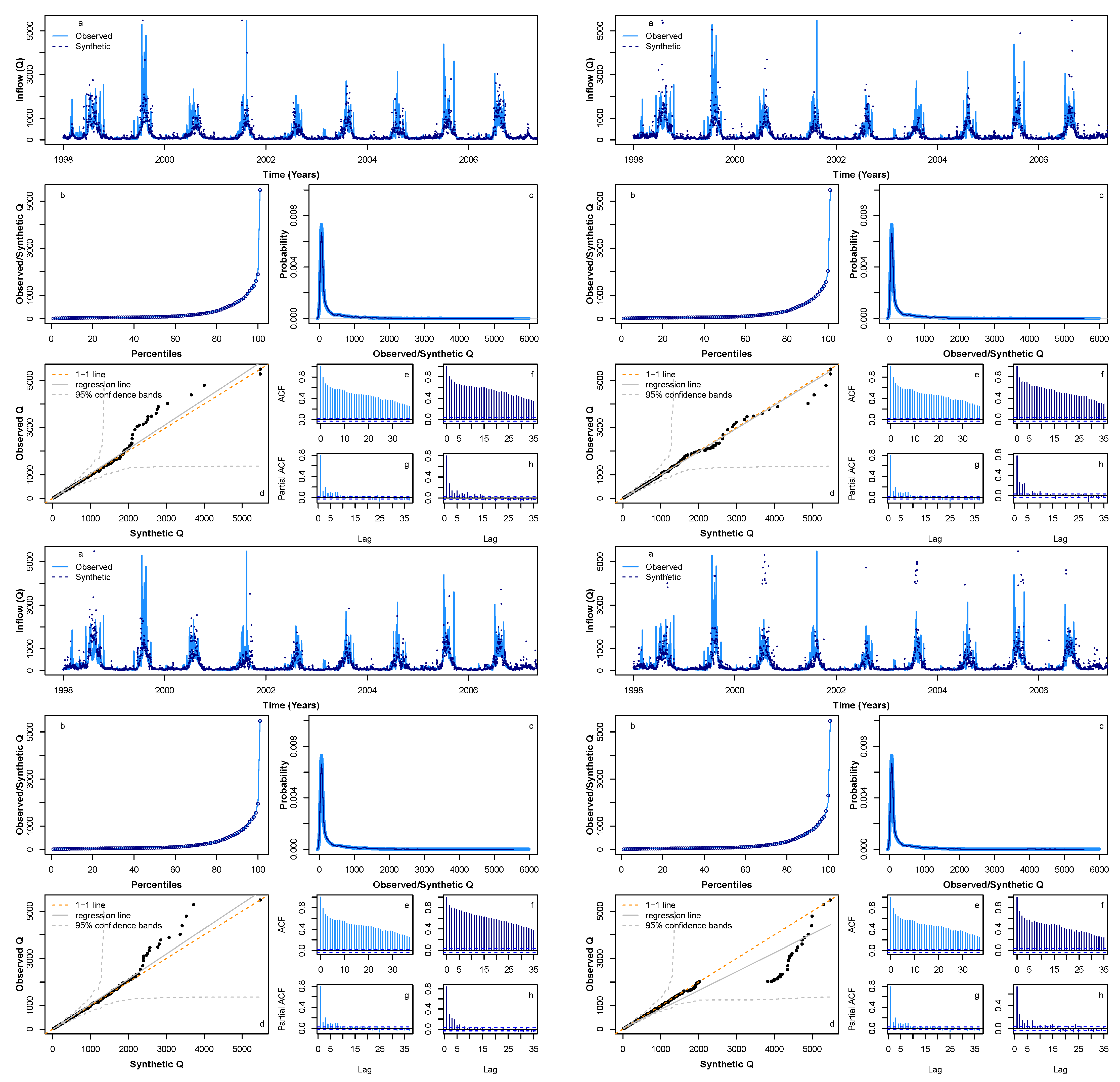
References
- Gleick, P.H. Streamflow and the Water Cycle. In Encyclopedia of Climate and Weather; Oxford University Press: New York, NY, USA, 1996; pp. 817–823. [Google Scholar]
- Johnson, A.C.; Acreman, M.C.; Dunbar, M.J.; Feist, S.W.; Giacomello, A.M.; Gozlan, R.E.; Hinsley, S.A.; Ibbotson, A.T.; Jarvie, H.P.; Jones, J.I.; et al. The British river of the future: How climate change and human activity might affect two contrasting river ecosystems in England. Sci. Total Environ. 2009, 407, 4787–4798. [Google Scholar] [CrossRef] [PubMed]
- Robins, P.E.; Skov, M.W.; Lewis, M.J.; Giménez, L.; Davies, A.G.; Malham, S.K.; Neill, S.P.; McDonald, J.E.; Whitton, T.A.; Jackson, S.E.; et al. Impact of climate change on UK estuaries: A review of past trends and potential projections. Estuar. Coast. Shelf Sci. 2016, 169, 119–135. [Google Scholar] [CrossRef]
- Visser-Quinn, A.; Beevers, L.; Patidar, S. A coupled modelling framework to assess the hydroecological impact of climate change. Environ. Model. Softw. 2019, 114, 12–28. [Google Scholar] [CrossRef]
- Walther, G.R.; Post, E.; Convey, P.; Menzel, A.; Parmesan, C.; Beebee, T.J.; Fromentin, J.M.; Hoegh-Guldberg, O.; Bairlein, F. Ecological responses to recent climate change. Nature 2002, 416, 386–395. [Google Scholar] [CrossRef]
- Whitehead, P.G.; Wade, A.J.; Butterfield, D. Potential impacts of climate change on water quality and ecology in six UK rivers. Hydrol. Res. 2009, 40, 113–122. [Google Scholar] [CrossRef]
- Visser-Quinn, A.; Beevers, L.; Collet, L.; Formetta, G.; Smith, K.; Wanders, N.; Thober, S.; Pan, M.; Kumar, R. Spatio-temporal analysis of compound hydro-hazard extreme across the UK. Adv. Water Resour. 2019, 130, 77–90. [Google Scholar] [CrossRef]
- Seneviratne, S.; Nicholls, N.; Easterling, D.; Goodess, C.; Kanae, S.; Kossin, J.; Luo, Y.; Marengo, J.; Mc Innes, K.; Rahimi, M.; et al. Changes in climate extremes and their impacts on the natural physical environment. In Managing the Risks of Extreme Events and Disasters to Advance Climate Change Adaptation; A Special Report of Working Groups I and II of the Intergovernmental Panel on ClimateChange (IPCC); Cambridge University Press: Cambridge, UK; New York, NY, USA, 2012; pp. 109–230. [Google Scholar]
- Walker, G.T. Correlation in seasonal variation of weather. Q. J. R. Meteorol. Soc. 1918, 44, 223–224. [Google Scholar]
- Webster, P.J.; Yang, S. Monsoon and ENSO: Selectively interactive systems. Q. J. R. Meteorol. Soc. 1992, 118, 877–926. [Google Scholar] [CrossRef]
- Webster, P.J.; Magaña, V.O.; Palmer, T.N.; Shukla, J.; Tomas, R.A.; Yanai, M.; Yasunari, T. Monsoons: Processes, predictability, and the prospects for prediction. J. Geophys. Res. 1998, 103, 14450–14451. [Google Scholar] [CrossRef]
- McPhaden, M.J.; Zebiak, S.E.; Glantz, M.H. ENSO as an Integrating Concept in Earth Science. Science 2006, 314, 1740–1745. [Google Scholar] [CrossRef]
- Collins, M.; An, S.I.; Cai, W.; Ganachaud, A.; Guilyardi, E.; Jin, F.F.; Jochum, M.; Lengaigne, M.; Power, S.; Timmermann, A.; et al. The impact of global warming on the tropical Pacific Ocean and El Niño. Nat. Geosci. 2010, 3, 391–397. [Google Scholar] [CrossRef]
- Cai, W.; McPhaden, M.J.; Grimm, A.M.; Rodrigues, R.R.; Taschetto, A.S.; Garreaud, R.D.; Dewitte, B.; Poveda, G.; Ham, Y.G.; Santoso, A.; et al. Climate impacts of the El Niño Southern Oscillation on South America. Nat. Rev. Earth Environ. 2020, 1, 215–231. [Google Scholar] [CrossRef]
- Fan, F.; Dong, X.; Fang, X.; Xue, F.; Zheng, F.; Zhu, J. Revisiting the relationship between the South Asian summer monsoon drought and El Niño warming pattern. Atmos. Sci. Lett. 2017, 18, 175–182. [Google Scholar] [CrossRef]
- Early Warning Early Action Report on Food Security and Agriculture (April–June 2019); Licence: CC BY-NC-SA 3.0 IGO; Food and Agriculture Organization of the United Nations (FAO): Rome, Italy, 2019.
- Patidar, S.; Allen, D.; Haynes, R.; Haynes, H. Stochastic modelling of flow sequences for improved prediction of fluvial flood hazards. Geol. Soc. Lond. Spec. Publ. (Geol. Soc. Lond.) 2018, 488, 205–219. [Google Scholar] [CrossRef]
- Gergis, J.L.; Fowler, A.M. A history of ENSO events since A.D. 1525:implications for future climate change. Clim. Chang. 2009, 92, 343–387. [Google Scholar] [CrossRef]
- Tsonis, A.A.; Hunt, A.G.; Elsner, J.B. On the relation between ENSO and global climate change. Meteorol. Atmos. Phys. 2003, 84, 229–242. [Google Scholar] [CrossRef]
- Trenberth, K.E.; Hoar, T.J. E1 Nifio and climate change. Geophhysical Res. Lett. 1997, 24, 3057–3060. [Google Scholar] [CrossRef]
- Wang, B.; Luo, X.; Yang, Y.M.; Sun, W.; Cane, M.A.; Cai, W.; Yeh, S.W.; Liu, J. Historical change of El Niño properties sheds light on future changes of extreme El Niño. Proc. Natl. Acad. Sci. USA 2019, 116, 22512–22517. [Google Scholar] [CrossRef]
- Stevenson, S.L. Significant changes to ENSO strength and impacts in the twenty? First century: Results from CMIP5. Geophys. Res. Lett. 2012, 39, L17703. [Google Scholar] [CrossRef]
- Bhandari, S.; Kalra, A.; Tamaddun, K.; Ahmad, S. Relationship between Ocean-Atmospheric Climate Variables and Regional Streamflow of the Conterminous United States. Hydrology 2018, 5, 30. [Google Scholar] [CrossRef]
- Bradley, R.S.; Diaz, H.F.; Kiladis, G.N.; Eischeid, J.K. ENSO signal in continental temperature and precipitation records. Nature 1987, 327, 497–501. [Google Scholar] [CrossRef]
- Halpert, M.S.; Ropelewski, C.F. Surface temperature patterns associated with the Southern Oscillation. J. Clim. 1992, 5, 577–593. [Google Scholar] [CrossRef]
- Ropelewski, C.F.; Halpert, M.S. Global and regional scale precipitation patterns associated with the El Niño/Southern Oscillation. Mon. Weather. Rev. 1987, 115, 1606–1626. [Google Scholar] [CrossRef]
- Ropelewski, C.F.; Halpert, M.S. Precipitation patterns associated with the high index phase of the Southern Oscillation. J. Clim. 1989, 2, 268–284. [Google Scholar] [CrossRef]
- Ropelewski, C.F.; Halpert, M.S. Quantifying Southern Oscillation? Precipitation relationships. J. Clim. 1989, 9, 1043–1059. [Google Scholar] [CrossRef]
- Chen, D.; Cane, M.A. El Niño prediction and predictability. J. Comput. Phys. 2008, 227, 3625–3640. [Google Scholar] [CrossRef]
- Clarke, A.J. El Niño physics and El Niño predictability. Annu. Rev. Mar. Sci. 2014, 6, 79–99. [Google Scholar] [CrossRef]
- Dijkstra, H.A.; Petersik, P.; Hernández-Garcia, E.; López, C. The application of machine learning techniques to improve El Niño prediction skill. Front. Phys. 2019, 7, 1–13. [Google Scholar] [CrossRef]
- Ham, Y.G.; Kim, J.H.; Luo, J.J. Deep Learning for Multiyear ENSO Forecasts. Nature 2019, 573, 568–572. [Google Scholar] [CrossRef]
- Tamaddun, K.A.; Kalra, A.; Bernardez, M.; Ahmad, S. Effects of ENSO on Temperature, Precipitation, and Potential Evapotranspiration of North India’s Monsoon: An Analysis of Trend and Entropy. Water 2019, 11, 189. [Google Scholar] [CrossRef]
- Islam, M.N.; Sivakumar, B. Characterization and prediction of runoff dynamics: A nonlinear dynamical view. Adv. Water Resour. 2002, 25, 179–190. [Google Scholar] [CrossRef]
- Jayawardena, A.W.; Lai, F. Analysis and prediction of chaos in rainfall and stream flow time series. J. Hydrol. 1994, 153, 23–52. [Google Scholar] [CrossRef]
- Porporato, A.; Ridolfi, L. Nonlinear analysis of river flow time sequences. Water Resour. Res. 1997, 33, 1353–1367. [Google Scholar] [CrossRef]
- Liu, Q.; Islam, S.; Rodriguez-lturbe, I.; Le, Y. Phase-space analysis of daily streamflow: Characterization and prediction. Adv. Water Resour. 1998, 21, 463–475. [Google Scholar] [CrossRef]
- Dhanya, C.T.; Kumar, N.D. Multivariate nonlinear ensemble prediction of daily chaotic rainfall with climate inputs. J. Hydrol. 2010, 403, 292–306. [Google Scholar] [CrossRef]
- Lu, Z.Q.; Berliner, L.M. Markov switching time series models with application to a daily runoff series. Water Resour. Res. 1999, 35, 523–534. [Google Scholar] [CrossRef]
- Lampinen, J.; Vehtari, A. Bayesian approach for neural networks?review and case studies. Neural Netw. 2001, 14, 257–274. [Google Scholar] [CrossRef]
- Shinohara, Y.; Kumagai, T.; Otsuki, K.; Kume, A.; Wada, N. Impact of climate change on runoff from a mid-latitude mountainous catchment in central Japan. Hydrol. Process. 2009, 23, 1418–1429. [Google Scholar] [CrossRef]
- Halff, A.H.; Halff, H.M.; Azmoodeh, M. Predicting runoff from rainfall using neural networks. In Engineering Hydrology; American Society of Civil Engineers: Reston, VA, USA, 1993; Volume 23, pp. 760–765. [Google Scholar]
- Kabir, S.; Patidar, S.; Pender, G. Investigating capabilities of machine learning techniques in forecasting stream flow. Proceed. Institut. Civil Eng. Water Manag. 2020, 173, 69–86. [Google Scholar] [CrossRef]
- Frigessi, A.; Haug, O.; Rue, H. A dynamic mixture model for unsupervised tail estimation without threshold selection. Exremes 2002, 5, 219–235. [Google Scholar] [CrossRef]
- Embrechts, P.; Kluppelberg, C.; Mikosch, T. Modelling Extremal Events; Springer: Berlin/Heidelberg, Germany, 1997. [Google Scholar]
- Carreau, J.; Naveau, P.; Sauquet, E. A statistical rainfall?runoff mixture model with heavy? tailed components. Water Resour. Res. 2009, 45, 10. [Google Scholar] [CrossRef]
- Chavez–Demoulin, V.; Davison, A.C. Generalized additive modelling of sample extremes. J. R. Stat. Soc. Appl. Stat. Ser. C 2005, 54, 207–222. [Google Scholar] [CrossRef]
- Coulibaly, P.; Bobée, B.; Anctil, F. Improving extreme hydrologic events forecasting using a new criterion for artificial neural network selection. Hydrol. Process. 2001, 15, 1533–1536. [Google Scholar] [CrossRef]
- Comte, L.; Buisson, L.; Daufresne, M.; Grenouillet, G. Climate?induced changes in the distribution of freshwater fish: Observed and predicted trends. Freshw. Ecol. 2013, 58, 625–639. [Google Scholar] [CrossRef]
- Hulme, M. Attributing weather extremes to ? Climate change?: A review. Prog. Phys. Geogr. Earth Environ. 2014, 38, 499–511. [Google Scholar] [CrossRef]
- Thompson, R.M.; Beardall, J.; Beringer, J.; Grace, M.; Sardina, P. Means and extremes: Building variability into community level climate change experiments. Ecol. Lett. 2013, 16, 799–806. [Google Scholar] [CrossRef]
- Woodward, G.; Bonada, N.; Brown, L.E.; Death, R.G.; Durance, I.; Gray, C.; Hladyz, S.; Ledger, M.E.; MIlner, A.M.; Ormerod, S.J.; et al. The effects of climatic fluctuations and extreme events on running water ecosystems. Philos. Trans. R. Soc. B (Biol. Sci.) 2016, 371, 20150274. [Google Scholar] [CrossRef]
- Abrahams, C.; Brown, L.; Dale, K.; Edwards, F.; Jeffries, M.J.; Klaar, M.; Ledger, M.E.; May, L.; Milner, A.M.; Murphy, J.A.; et al. The impact of extreme events on freshwater ecosystems. In Ecological Issues Special Publication; British Ecological Society: London, UK, 2013. [Google Scholar]
- Adebayo, A.J.; Soundharajan, B.S.; Ojha, C.S.P.; Remesan, R. Effect of hedging-integrated rule curves on the performance of the Pong reservoir (India) during scenario-neutral climate change perturbations. Water Resour. Manag. 2016, 30, 445–470. [Google Scholar]
- Soundharajan, B.S.; Adeloye, A.J.; Remesan, R.; Ojha, C.S. Simulating the performance of the Pong Reservoir in India under climate change perturbations. In Proceedings of the Dooge-Nash International Symposium, Dublin, Ireland, 24–25 April 2014. [Google Scholar]
- Ncube, S.; Beevers, L.; Adeloye, A.; Visset, A. Assessment of freshwater ecosystem services in the Beas River Basin, Himalayas region, India. In Proceedings of the International Association of Hydrological Sciences—8th International Symposium on Integrated Water Resources Management 2018, Beijing, China, 13–15 June 2018. [Google Scholar]
- Prasad, V.H.; Roy, P.S. Estimation of Snowmelt Runoff in Beas Basin, India. Geocarto Int. 2005, 20, 41–47. [Google Scholar] [CrossRef]
- Patidar, S.; Jenkins, D.P.; Peacock, A.; McCallum, P. A hybrid system of data-driven approaches for simulating residential energy demand profiles. J. Build. Perform. Simul. 2021, 14, 277–302. [Google Scholar] [CrossRef]
- Cleveland, R.B.; Cleveland, W.S.; McRae, J.E.; Terpenning, I. STL: A seasonal-trend decomposition. J. Off. Stat. 1990, 6, 3–73. [Google Scholar]
- Huang, Y.; Schmit, F.G.; Lu, Z.; Liu, Y. Analysis of daily river flow fluctuations using Empirical Mode Decomposition and arbitrary order Hilbert spectral analysis. J. Hydol. 2009, 373, 103–111. [Google Scholar] [CrossRef]
- Agana, N.A.; Homaifar, A. EMD-Based Predictive Deep Belief Network for Time Series Prediction: An Application to Drought Forecasting. J. Hydology 2018, 5, 18. [Google Scholar]
- Pender, D.; Patidar, S.; Pender, G.; Haynes, H. Stochastic simulation of daily streamflow sequences using a hidden Markov model. Hydrol. Res. 2015, 47, 75–88. [Google Scholar] [CrossRef]
- Metcalfe, A.V.; Cowpertwait, P.S. Introductory Time Series with R; Springer: New York, NY, USA, 2009. [Google Scholar]
- United States Climate Prediction Center, Historical El Niño/ La Niña Episodes (1950—Present), Maryland, USA. 2019. Available online: https://origin.cpc.ncep.noaa.gov/products/analysis_monitoring/ensostuff/ONI_v5.php (accessed on 12 May 2021).
- The R Project for Statistical Computing. Available online: https://www.r-project.org/ (accessed on 3 February 2021).
- Jain, S.K.; Ajanta, G.; Saraf, A.K. Assessment of snowmelt runoff using remote sensing and effect of climate change on runoff. Water Resour. Manag. 2010, 24, 1763–1777. [Google Scholar] [CrossRef]
- Krishna, B.; Satyaji Rao, Y.R.; Nayak, P.C. Time Series Modeling of River Flow Using Wavelet Neural Networks. J. Water Resour. Prot. 2011, 3, 3778. [Google Scholar] [CrossRef]
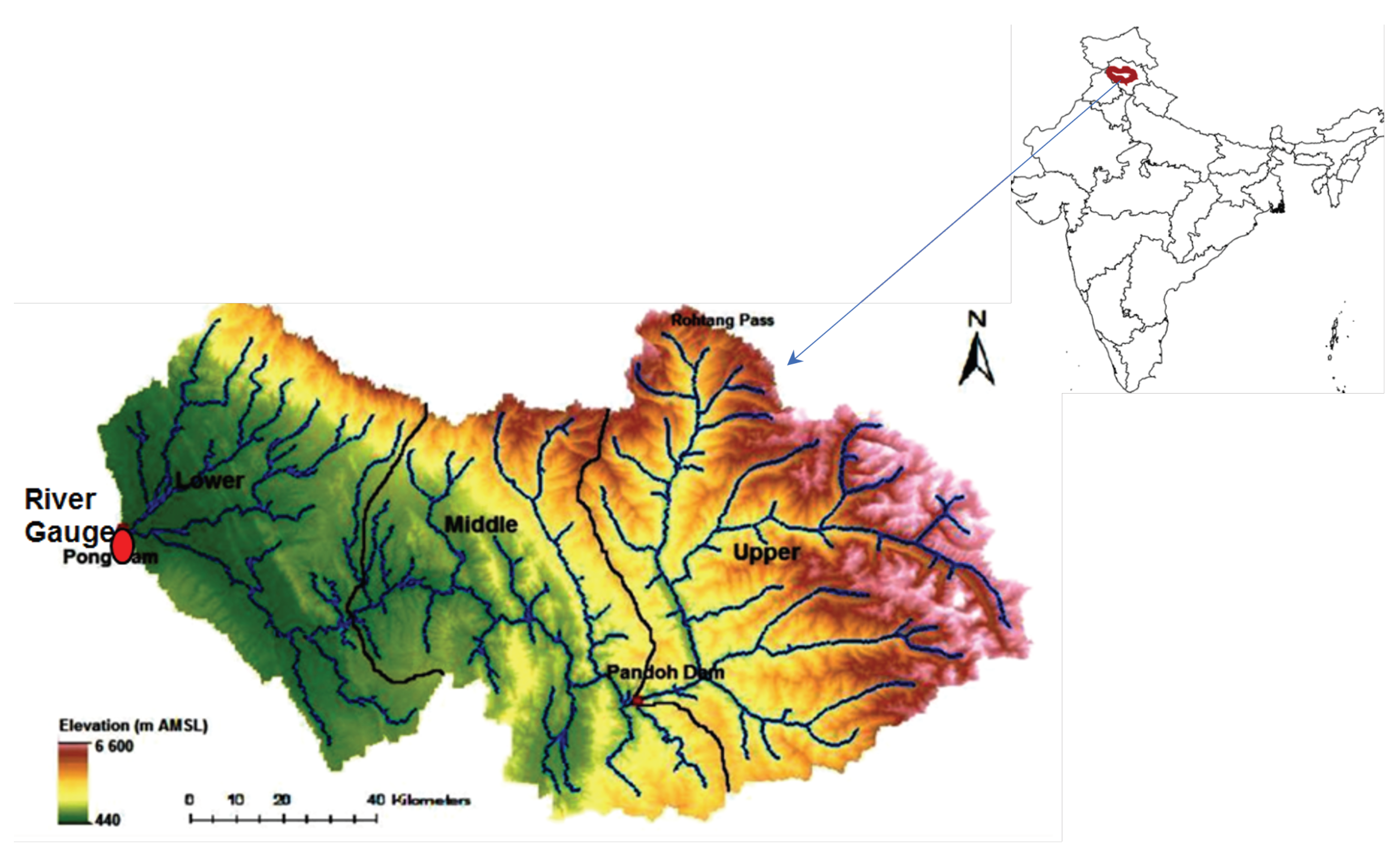
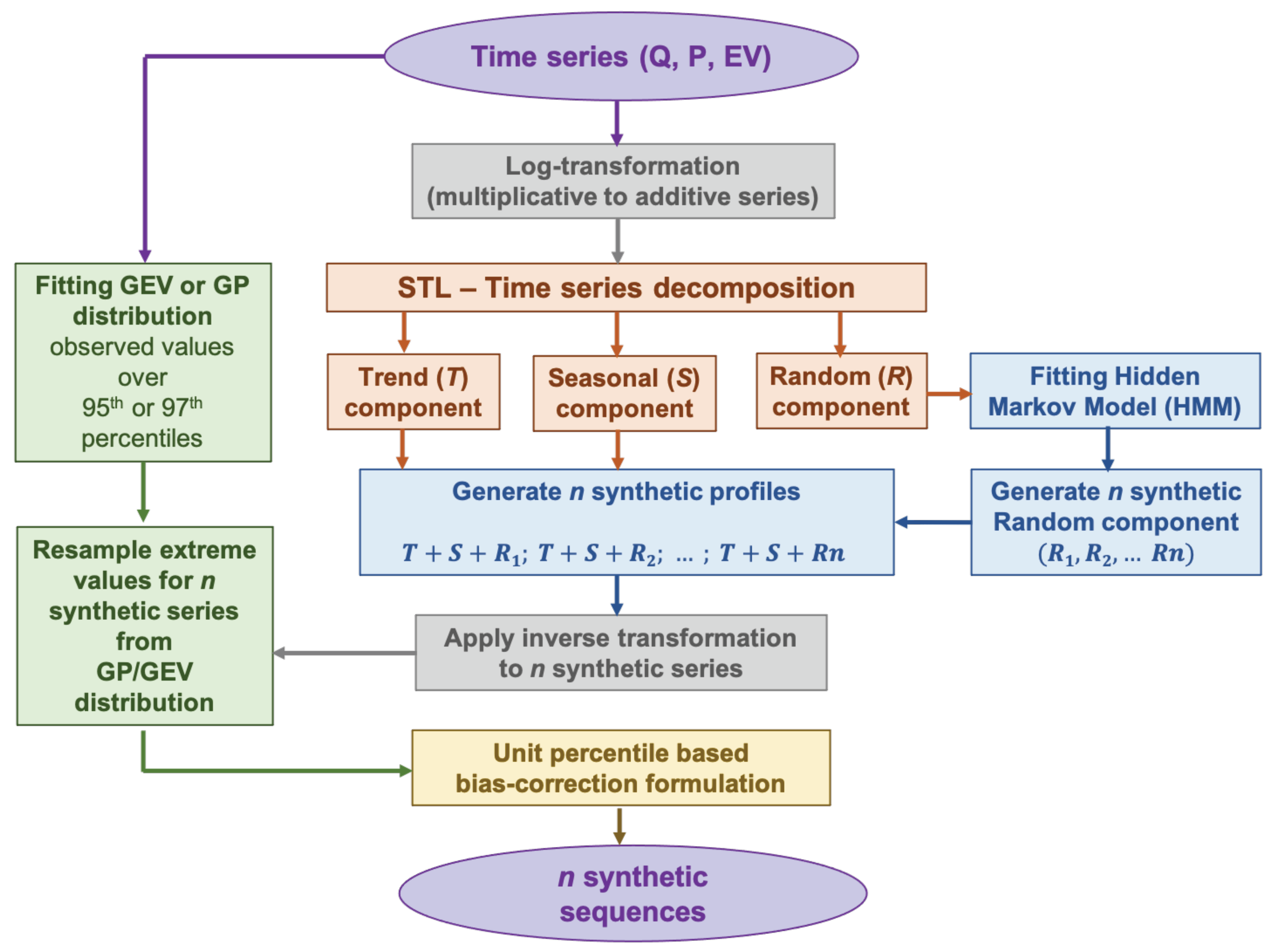
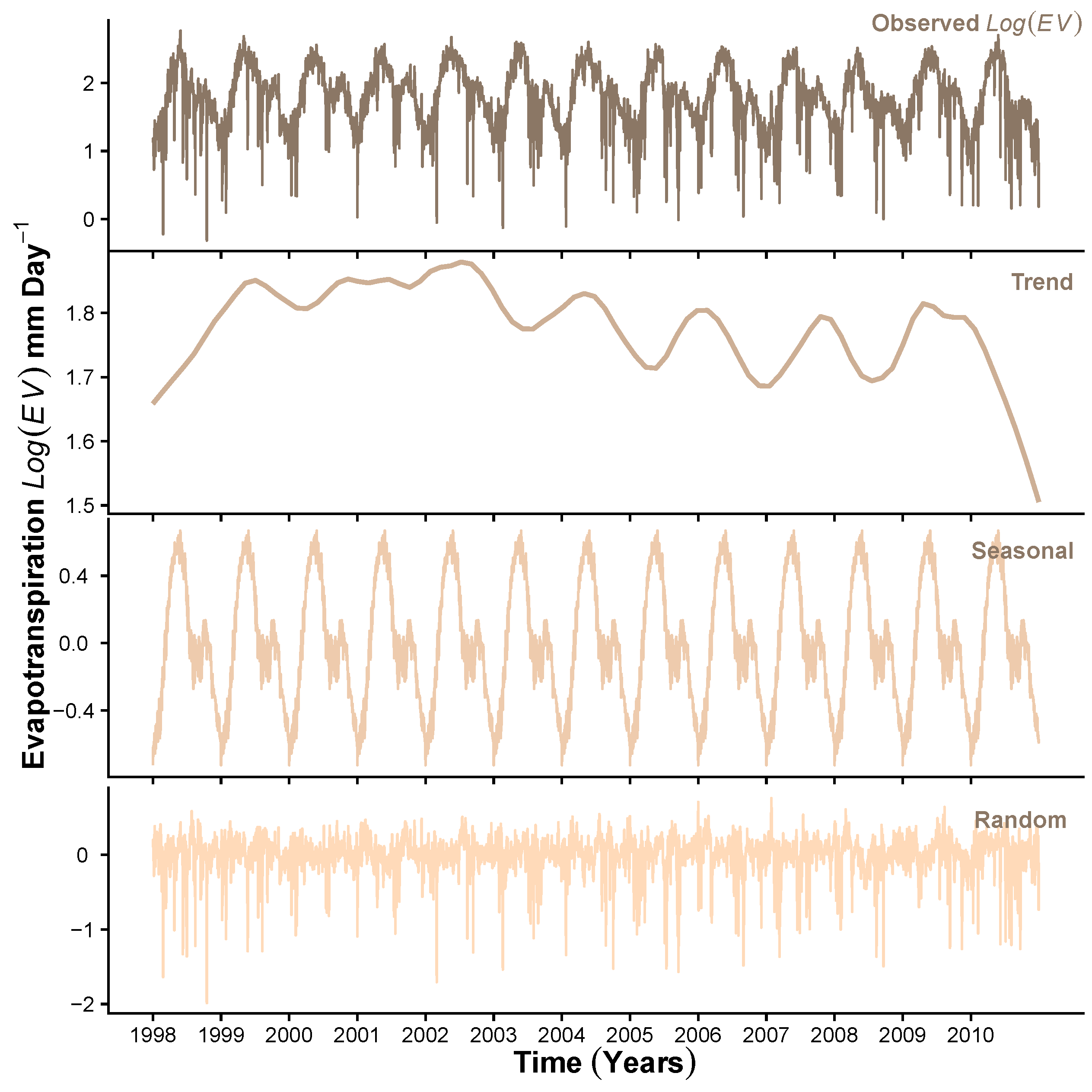
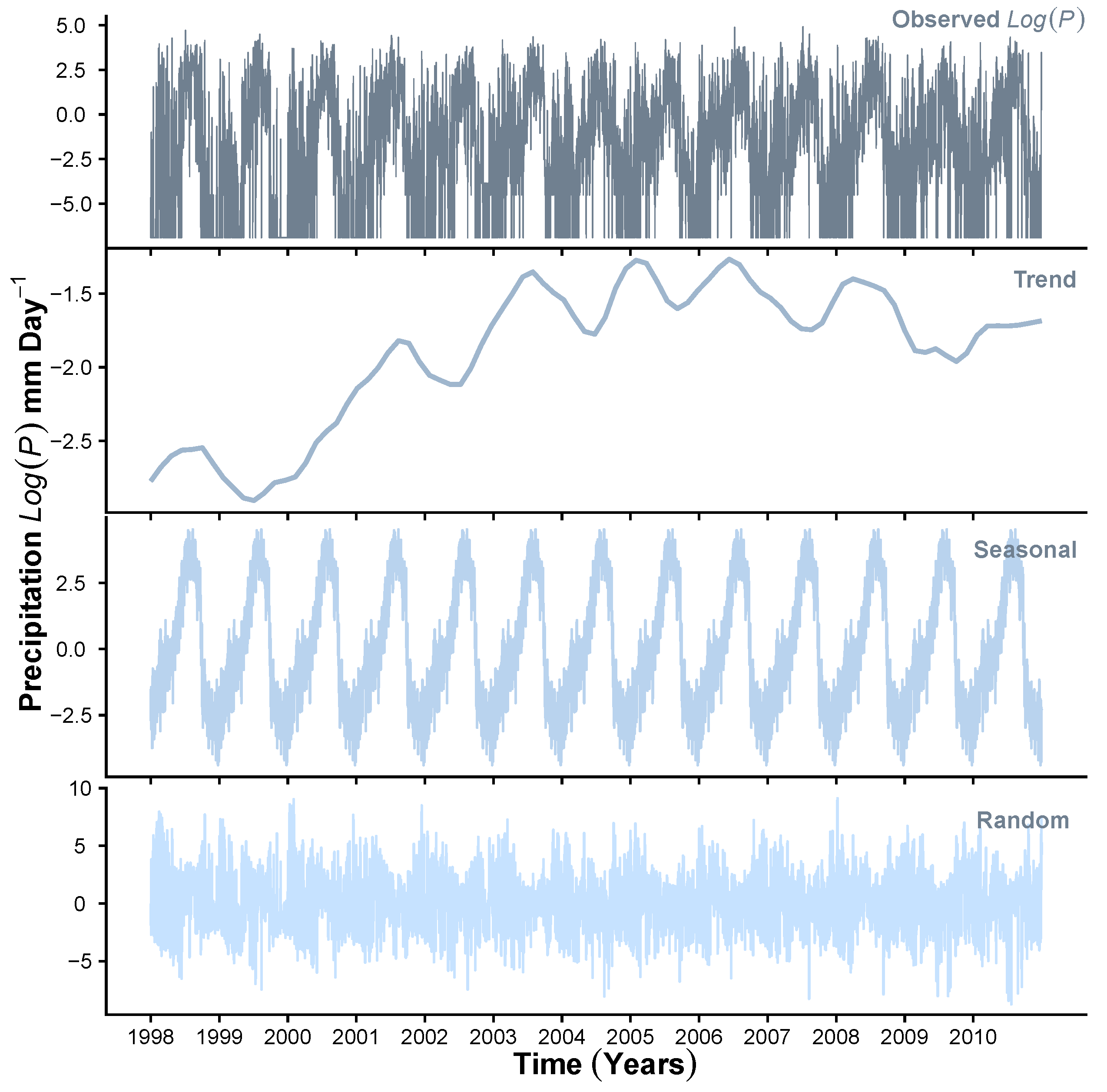
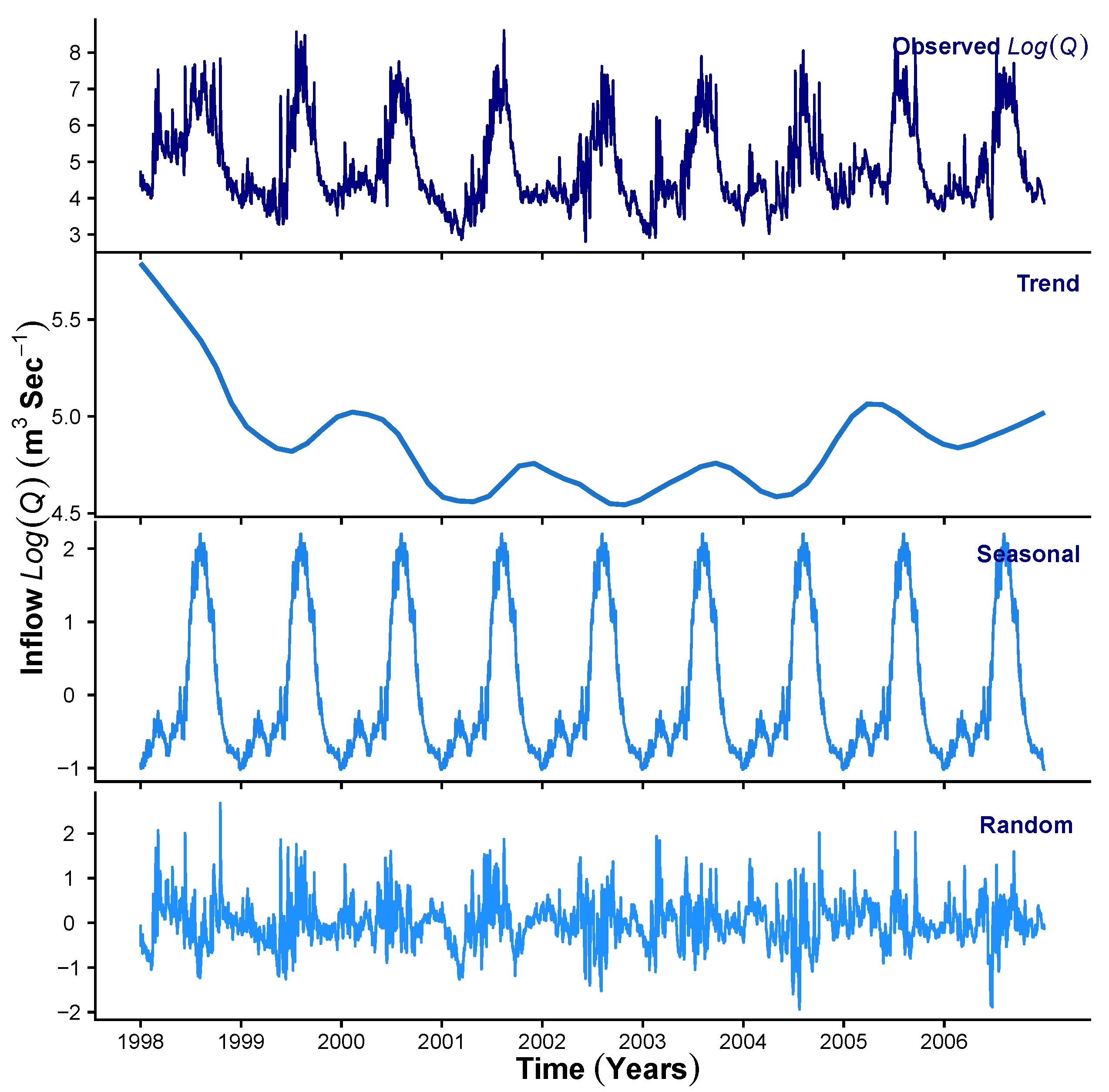
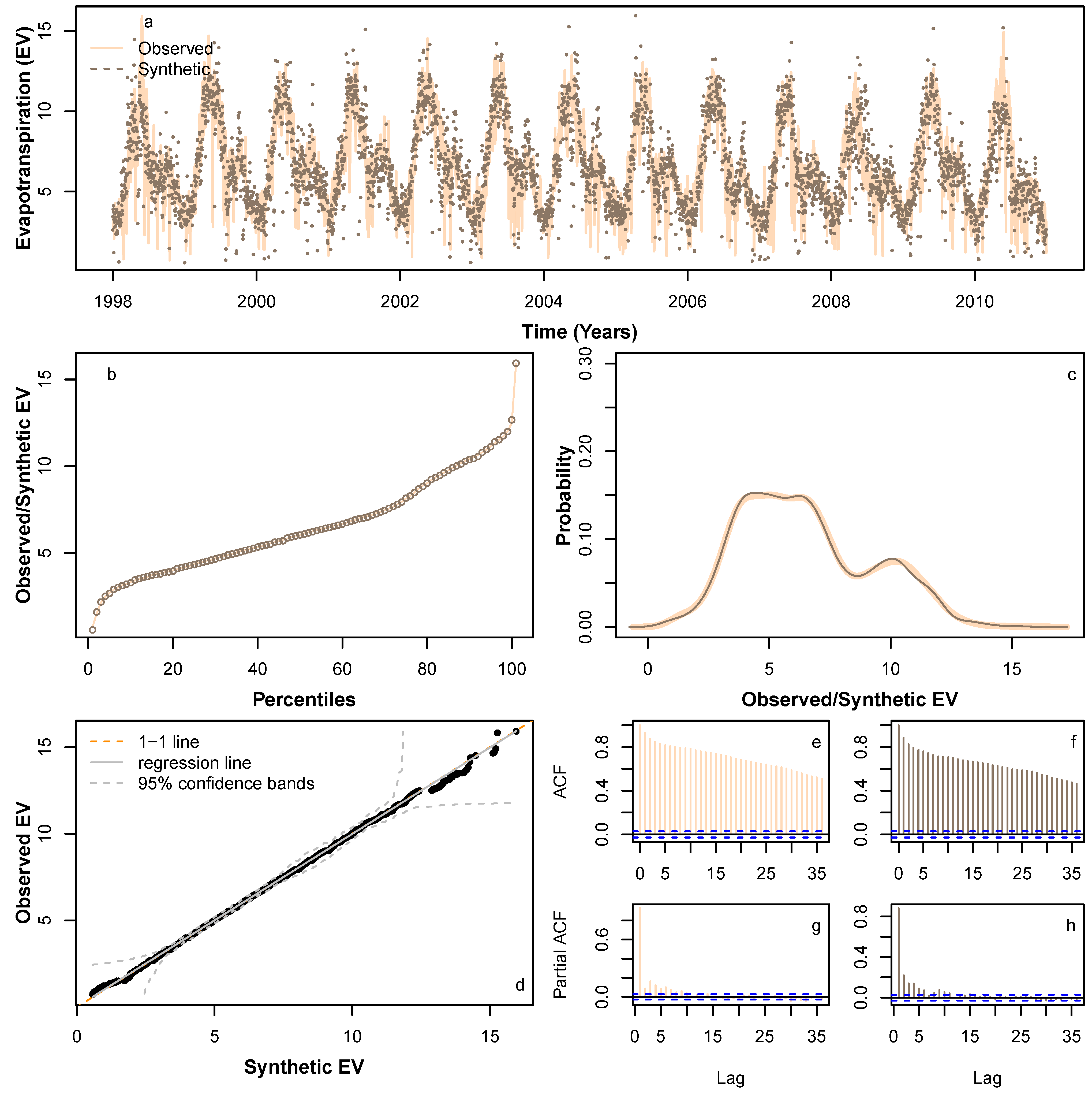
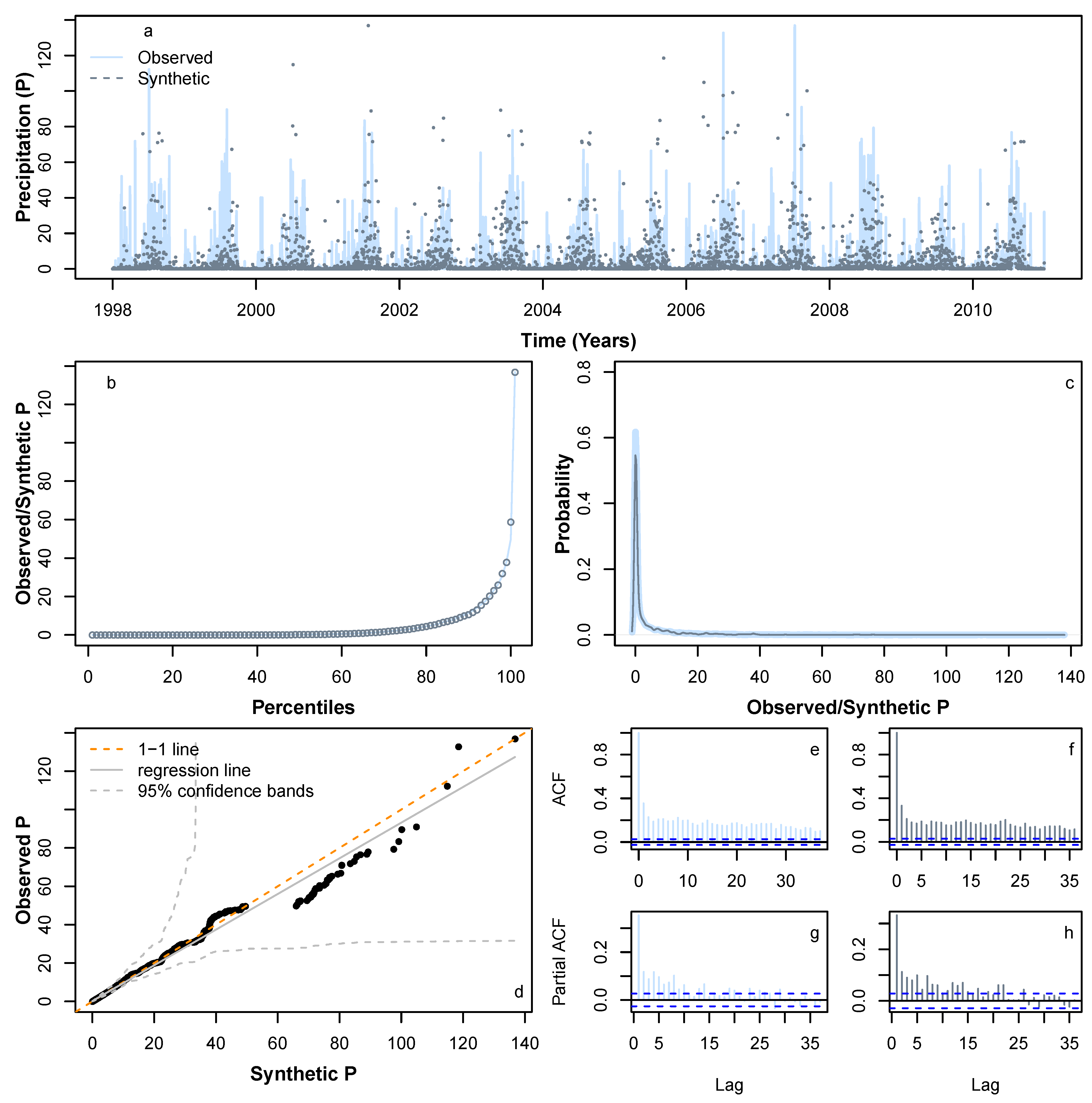
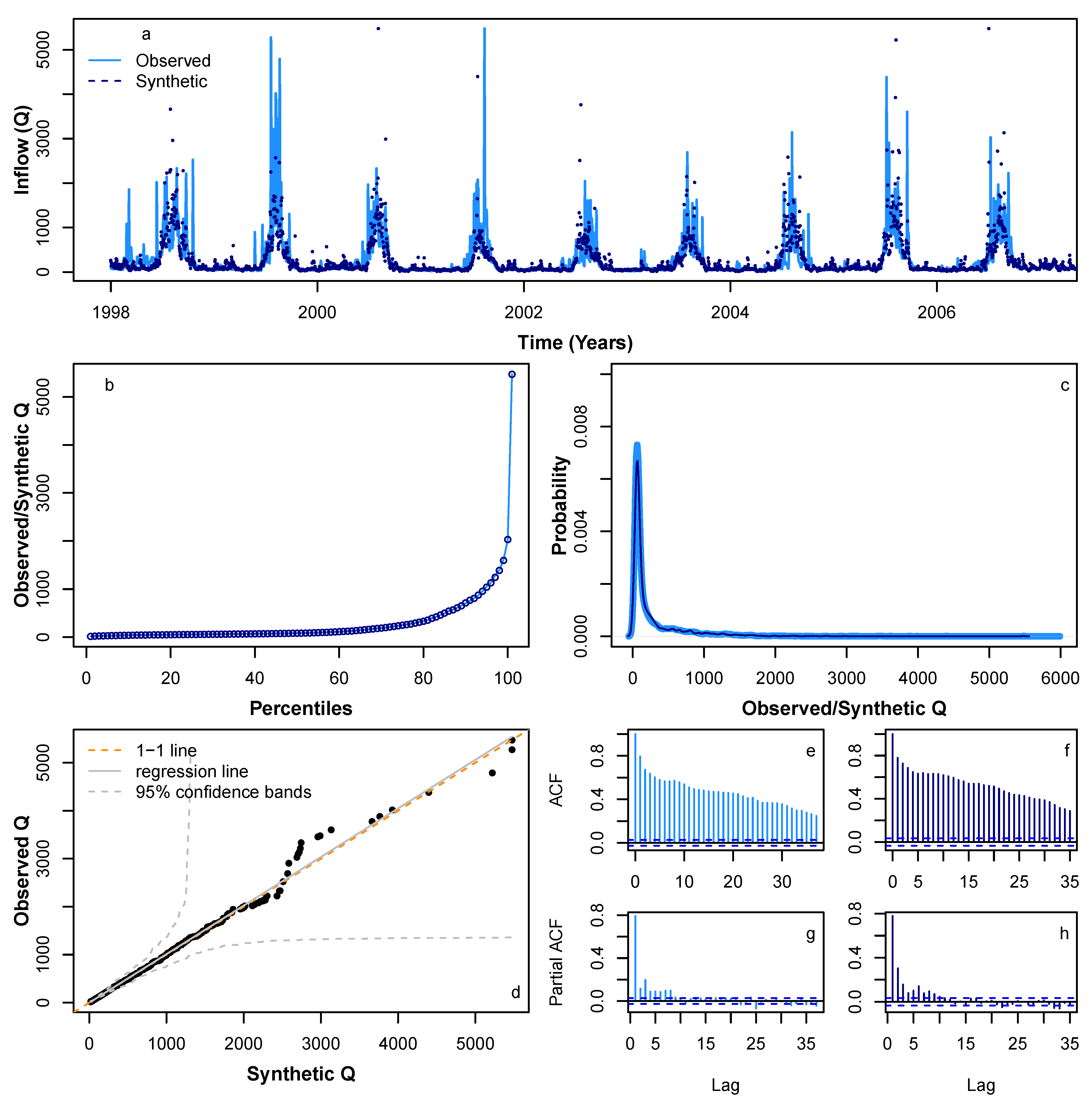
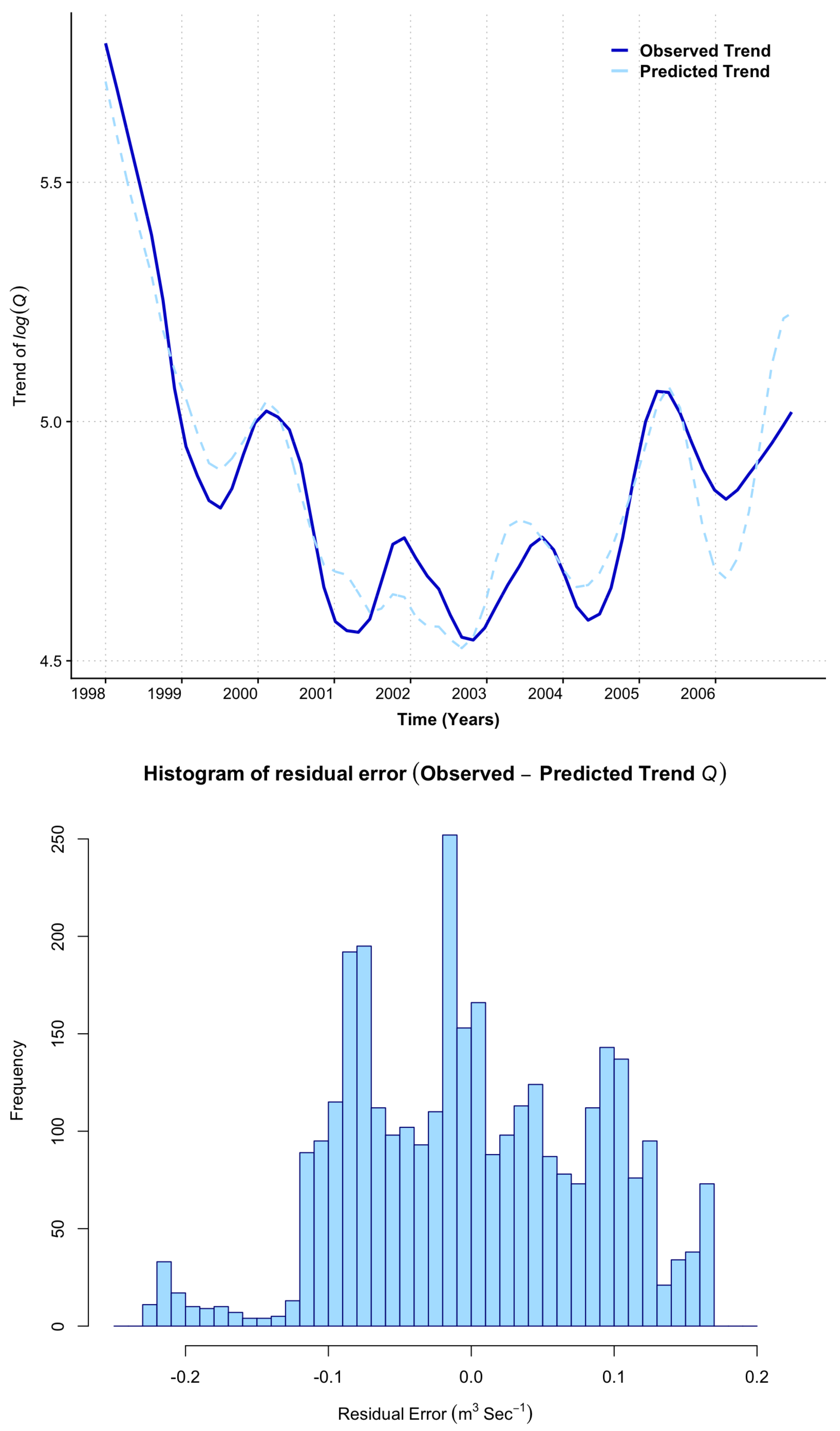
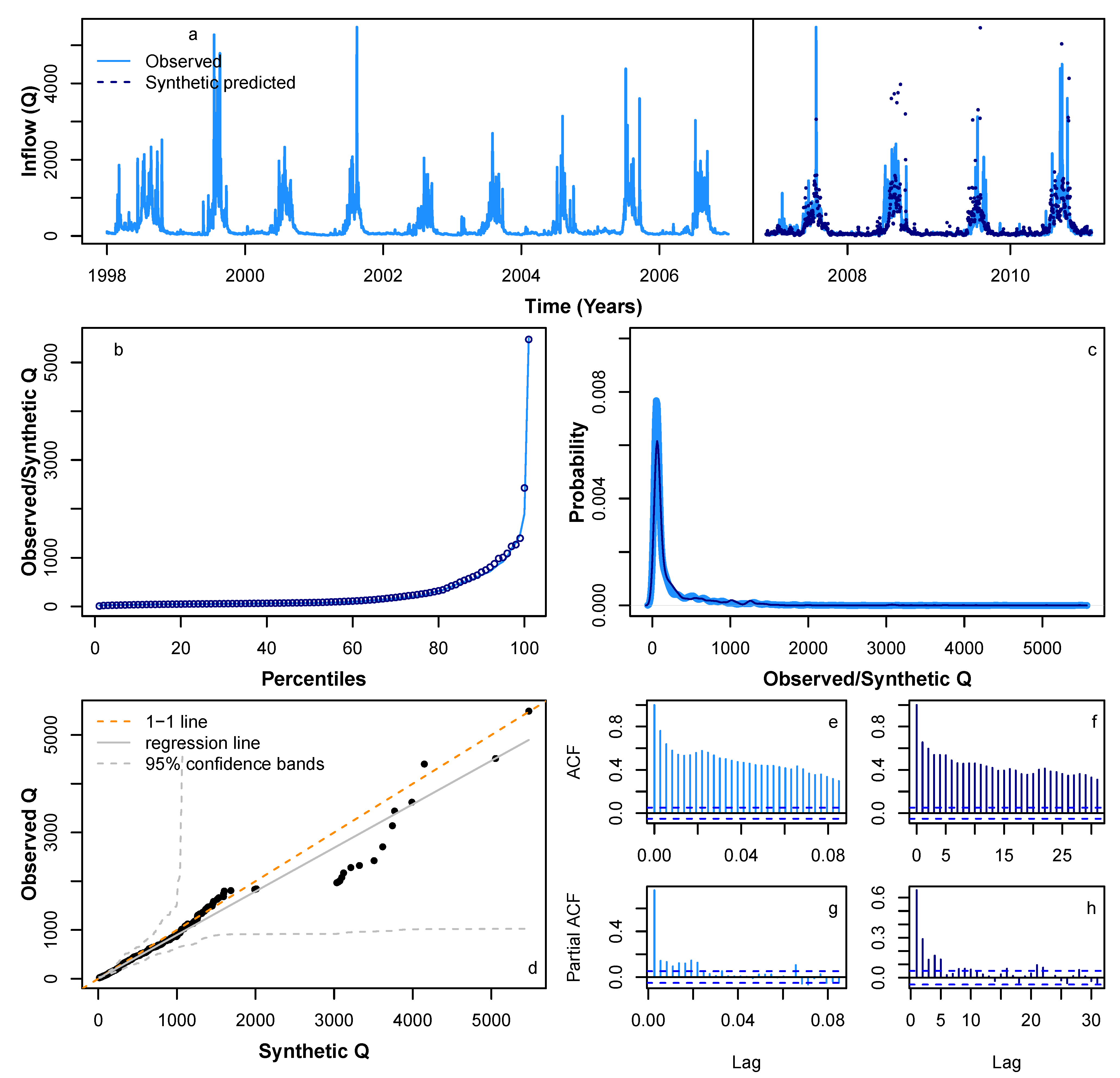
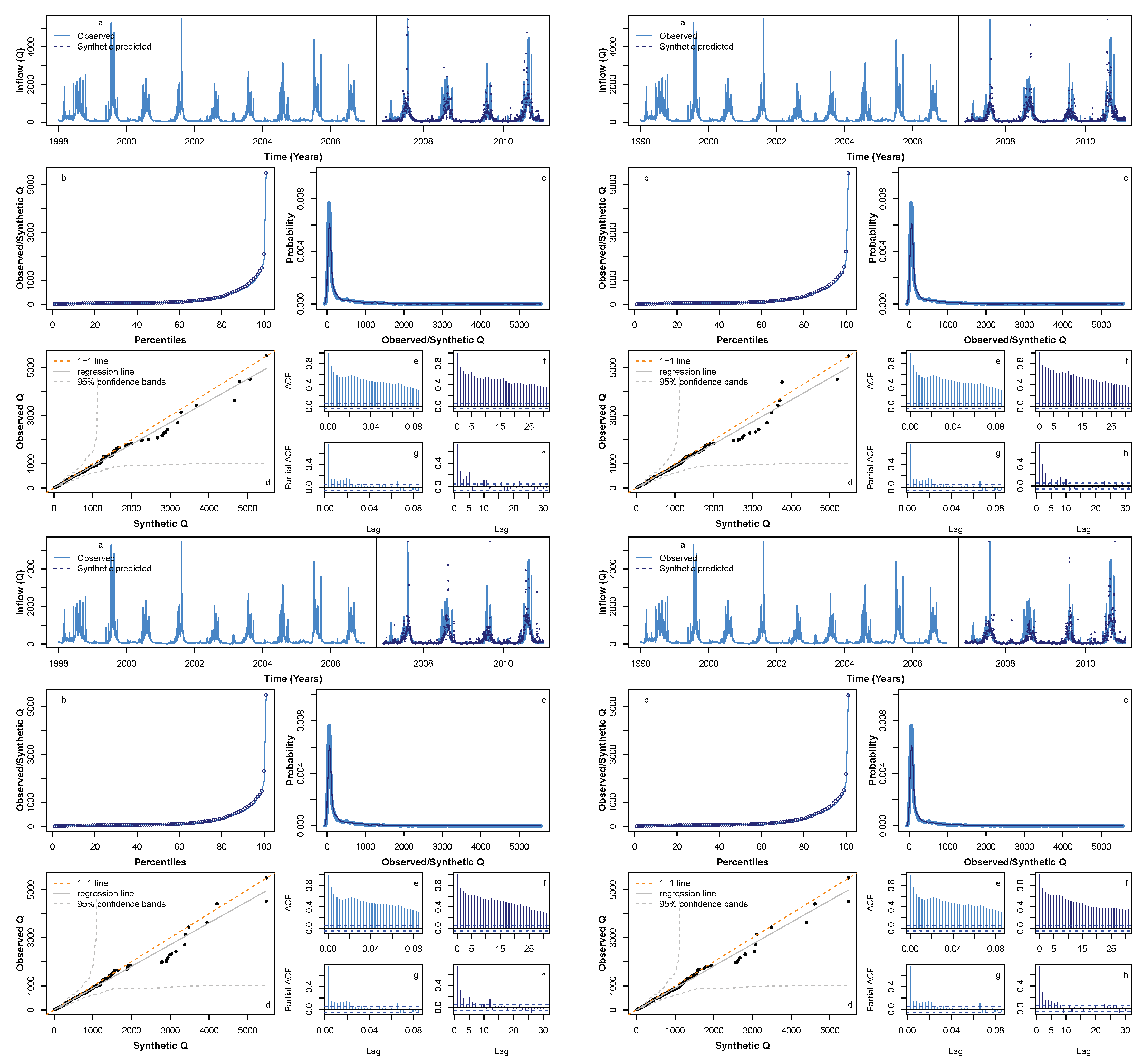

| Indices | Minimum | Mean | Maximum | |
|---|---|---|---|---|
| Sub-catchment: upper | P | 0.00 | 2.77 | 96.44 |
| 0.27 | 1.97 | 6.31 | ||
| 10.85 | 25.75 | |||
| 12.24 | ||||
| Sub-catchment: middle | P | 0.00 | 3.76 | 119.44 |
| 0.53 | 4.62 | 9.70 | ||
| 6.87 | 26.12 | 40.03 | ||
| 13.40 | 25.74 | |||
| Sub-catchment: lower | P | 0.00 | 4.12 | 136.83 |
| 0.73 | 6.58 | 15.92 | ||
| 10.71 | 32.78 | 50.30 | ||
| 18.45 | 33.16 |
| Set of observed states | Percentile analysis of random component is conducted to define eleven distinct states, State A—value between 0th and 10th percentile; State B—value between 11th and 20th percentile; ................................................................................... ; State K—value between 95th and 100th percentile |
| State transitional probability matrix | |
| Set of unobserved (hidden) states | Hidden states corresponding to each of eleven observed state are defined as |
| Emission probability matrix | Corresponding to each hidden state where |
| Initial Probability Matrix | Initial probabilities of occurrences of observed states, observed state are defined as |
| Percentiles | 0th | 5th | 10th | 25th | 50th | 75th | 90th | 95th | 100th |
|---|---|---|---|---|---|---|---|---|---|
| Residual error |
Publisher’s Note: MDPI stays neutral with regard to jurisdictional claims in published maps and institutional affiliations. |
© 2021 by the authors. Licensee MDPI, Basel, Switzerland. This article is an open access article distributed under the terms and conditions of the Creative Commons Attribution (CC BY) license (https://creativecommons.org/licenses/by/4.0/).
Share and Cite
Patidar, S.; Tanner, E.; Soundharajan, B.-S.; SenGupta, B. Associating Climatic Trends with Stochastic Modelling of Flow Sequences. Geosciences 2021, 11, 255. https://doi.org/10.3390/geosciences11060255
Patidar S, Tanner E, Soundharajan B-S, SenGupta B. Associating Climatic Trends with Stochastic Modelling of Flow Sequences. Geosciences. 2021; 11(6):255. https://doi.org/10.3390/geosciences11060255
Chicago/Turabian StylePatidar, Sandhya, Eleanor Tanner, Bankaru-Swamy Soundharajan, and Bhaskar SenGupta. 2021. "Associating Climatic Trends with Stochastic Modelling of Flow Sequences" Geosciences 11, no. 6: 255. https://doi.org/10.3390/geosciences11060255
APA StylePatidar, S., Tanner, E., Soundharajan, B.-S., & SenGupta, B. (2021). Associating Climatic Trends with Stochastic Modelling of Flow Sequences. Geosciences, 11(6), 255. https://doi.org/10.3390/geosciences11060255








